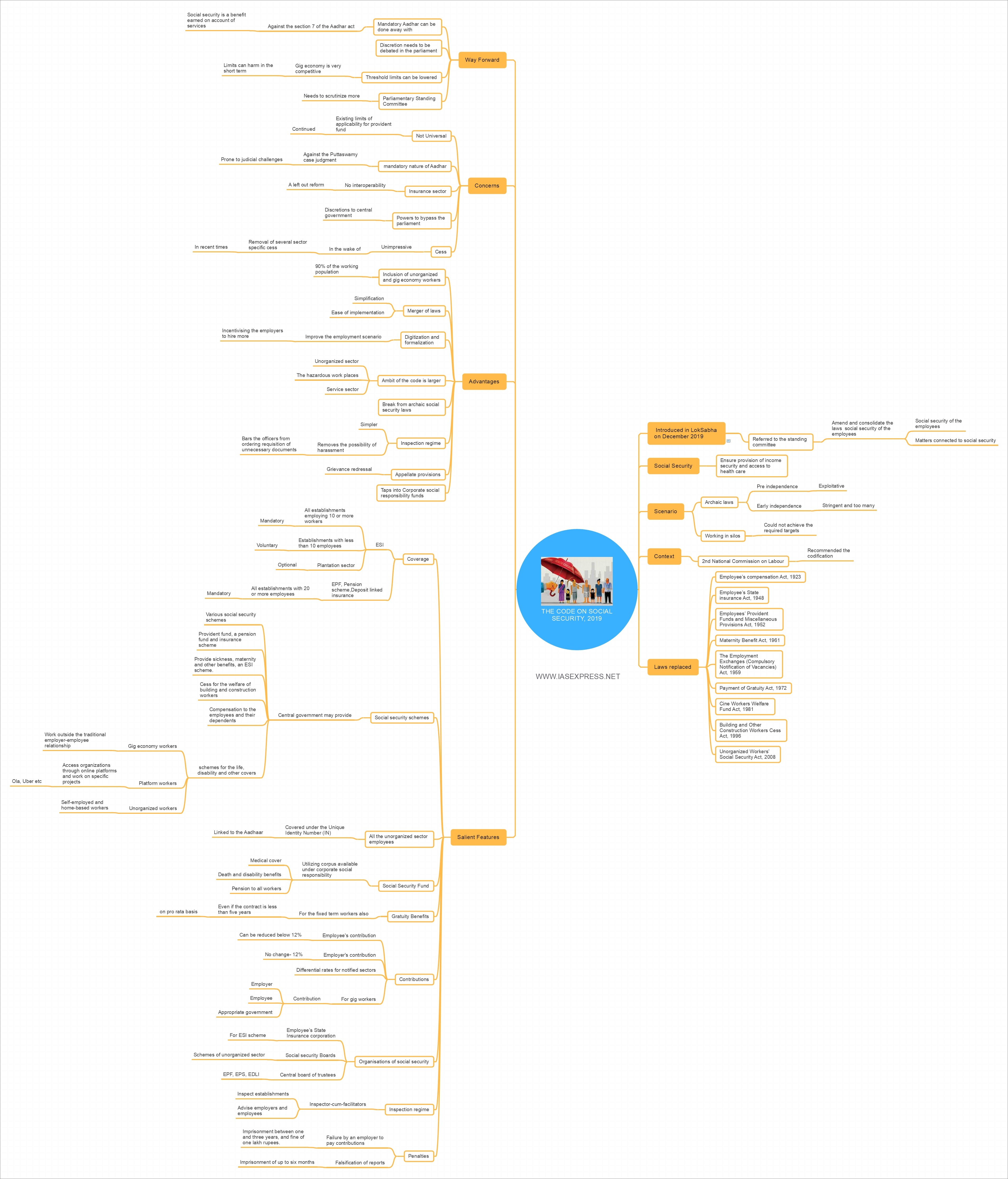The Code on Social Security 2019 – Need, Features, Advantages, Concerns

The Code on Social Security, 2019 was introduced in Lok Sabha in December 2019. It strives to amend and consolidate the laws relating to the social security of the employees and the matters connected to social security. The bill is with the standing committee now.
Social security refers to measures to ensure the provision of income security and access to health care to workers.
This topic of “The Code on Social Security 2019 – Need, Features, Advantages, Concerns” is important from the perspective of the UPSC IAS Examination, which falls under General Studies Portion.
What is the Social security scenario?
- For a country with rampant poverty and exploitative labour laws without social security at the dawn of independence, the social security legislations were important tools to bring equitable redistribution and justice. India has strived to bring under social security ambit various sections of society like labour, women, child labour and so on. But most important was the labour section saw a variety of statutes to take it under social security.
- The main problem with the social security laws was they were working in silos although catering to the same section. The multiplicity and complexity of the laws made them less successful in achieving their targets. The archaic nature also didn’t help as they didn’t capture the existing needs.
What is the context to bring the code?
- The codification of labour laws was recommended by the 2nd National Commission on Labour (2002)
- The labour ministry, accordingly, is in the process of amalgamation of labour laws (Total 44 in number) into four codes namely code on wages, Code on industrial relations, social security and safety code, and Code on health and working conditions. The Social Security Code, 2019 is one of the four labour codes approved by the Cabinet for the reform. The initiative is said to bring much-needed reforms in the archaic regime.
What is Social Security Code 2019?
It replaces the existing nine laws on social security. They are-
- Employee’s Compensation Act, 1923;
- Employee’s State Insurance Act, 1948;
- Employees’ Provident Funds and Miscellaneous Provisions Act, 1952;
- Maternity Benefit Act, 1961;
- The Employment Exchanges (Compulsory Notification of Vacancies) Act, 1959;
- Payment of Gratuity Act, 1972;
- Cine Workers Welfare Fund Act, 1981;
- Building and Other Construction Workers Cess Act, 1996;
- Unorganized Workers’ Social Security Act, 2008.
What are the key features of the code?
- Coverage
- Employee’s State Insurance.
- Extends coverage to all establishments employing 10 or more workers.
- For establishments with less than 10 employees the application is voluntary.
- For the Plantation sector, the code is optional.
- The central government may extend it to any establishment with hazardous work notified by the central government.
- Employee’s Provident Fund, Employee’s Pension scheme, and Deposit linked Insurance scheme-
- All industries or establishments employing 20 or more employees.
- Social security schemes–
- The central government may notify various social security schemes like the EPF scheme, Employee’s Pension scheme, Deposit linked insurance scheme for the benefit of workers.
- It may provide for a provident fund, a pension fund, and an insurance scheme.
- The central government may notify, to provide sickness, maternity, and other benefits, an ESI scheme.
- It may provide for a cess for the welfare of building and construction workers.
- It may also provide for compensation to the employees and their dependents for occupational injuries and diseases.
- The Central or state government may provide notify schemes for the life, disability and other covers for gig economy workers, platform workers, and unorganised workers.
- Who is a gig economy worker? The workers who work outside the traditional employer-employee relationship.
- Who is a Platform worker? Workers who access organisations through online platforms and work on specific projects. e.g. Ola, Uber workers
- Who is an Unorganised worker? These are self-employed and home-based workers. All the unorganized sector employees will now be covered under the Unique Identity Number(UIN) which will be linked to the Aadhaar which will be mandatory to avail benefits.
- Social security Fund-
The Code provides for setting up a social security fund by utilizing corpus available under corporate social responsibility. This fund will provide welfare benefits such as medical cover, death and disability benefits, pension to all workers, including gig workers.
- Gratuity Benefits-
Gratuity is provided for the fixed term workers also (Even if the contract is less than five years) on a pro-rata basis i.e. proportionate.
- Changes in Contributions–
- The EPS, EDLI, EPF, and ESI Schemes will be financed by a combination of the employer and employee.
- The bill provides the option of reducing provident fund contribution by the employee (currently at 12% of basic salary) and therefore increase workers take-home pay.
It does not change the employer’s contribution (12%).
- The bill allows the government to notify sectors where a lower/differential rate of contribution can be applicable.
- It will also empower the central government to exempt certain establishments from all or any of the provisions of the proposed code.
- All contributions towards payment of gratuity, maternity benefit, cess for building workers, and employee compensation will be borne by the employer.
- Schemes for gig workers, platform workers, and unorganised workers may be financed through a combination of contributions from the employer, employee, and the appropriate government.
- Organisations of Social security–
For the administration of social security schemes, the code provides for the establishment of various bodies such as-
- Employee’s State Insurance corporation- for ESI scheme
- Social security Boards- for the schemes of unorganised sector
- Central board of trustees- for EPF, EPS, EDLI
- The inspection regime–
- Appointment of Inspector-cum-facilitators to inspect establishments covered by the Code and advise employers and employees on compliance with the Code.
- Appellate Authority- Administrative officers under various schemes to hear the appeals.
- Penalty on Offences-
- The failure by an employer to pay contributions under the Code after deducting the employee’s share is punishable with imprisonment between one and three years, and fine of one lakh rupees.
- Falsification of reports is punishable with imprisonment of up to six months.
What are the Advantages?
- Inclusion of unorganised and gig economy workers which is 90% of the working population.
- The merger of laws makes for simplification and ease of implementation of the social security regime.
- The digitisation and formalisation will improve the employment scenario by incentivising employers to hire more. The previous regime was a tedious process.
- The ambit of the code is larger taking into account the unorganised sector and the hazardous workplaces also.
- The Code is a break from archaic social security laws from pre-independence and 70s of the 20th
- One such 21st-century reform is to bring the service sector under the ambit.
- The inspection regime is simpler and removes the possibility of harassment as it bars the officers from ordering requisition of unnecessary documents.
- The appellate provision on the code makes it easy for grievance redressal.
- It tries to tap into Corporate social responsibility funds for the benefit of workers.
- The demand for bringing Ola, Uber workers under social security has been met with.
What are the concerns raised?
- Since the Existing limits of applicability for the provident fund have not been removed, it falls short of being universal in character.
- The mandatory nature of Aadhar is against the Puttaswamy case judgment by the supreme court. It may be challenged in the courts.
- There is no interoperability of the products of the insurance sector making it a left-out reform.
- One serious issue raised is that the code gives powers to bypass the parliament by making it the sole authority on many provisions such as changing the contributions of the employees.
- The bringing of cess for the unorganised sector seems unimpressive in the wake of the removal of several sector-specific cesses in the recent past.
Way forward
The social security code is a big step in the direction of simplification, formalisation, and ease of doing business. But some of the concerns raised must be dealt with.
- The mandatory nature of Aadhar can be done away with as it is against section 7 of the Aadhar act as social security is a benefit earned on account of services by the employee.
- A large number of provisions give discretion to the central government which can be harmful to social security in the name of ease of doing business. These need to be debated in the parliament and required amendments are expected.
- Threshold limits can be lowered as the gig economy payments are competitive in nature and raising them could be harmful in the short term.
- It should be hoped that the parliamentary standing committee makes further scrutiny and recommends some changes to fill the gaps.
Conclusion
Though it needs to be passed in the parliament, the Code on Social Security, 2019 is a robust arrangement to effect economy, efficiency, and effectiveness in the working of the social security regime. The inclusion of unorganised sector is a welcome step as the economy right now is service sector dominated. Further positive changes too must be looked forward as they are in the long run are helpful to the wide sections.
Practice Question for Mains
Discuss the salient features of the Social Security Code, 2019. Critically analyse its provisions in bringing change in the situation of the unorganised sector workers. (250 words)



I hope this kind of mind map I can see in every article , it is precise and very easy to understand , those branches like mind maps are sometimes confusing and hard to understand